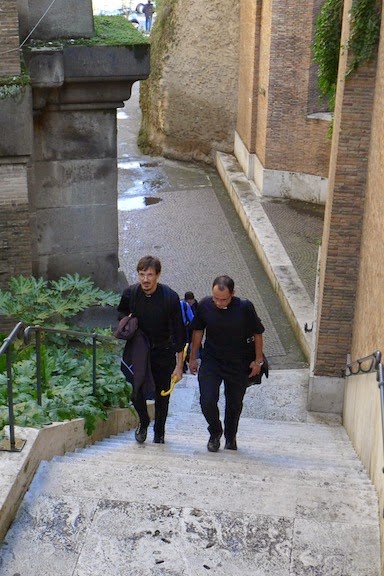It’s like a buffet of must-see spots that can be enjoyed in single stop. Although this is not uncommon in an ancient city such as Rome where just at every street corner a cornucopia of surprises unfold. But consider this “buffet” something special—the offerings are lip-smacking, so to speak.
It’s one of the seven hills in the city— the Capitoline Hill, a citadel (like the forum to the Greeks), where, once, one of the largest and the most beautiful temples of early Rome sat on. What sits on the hill today is a piazza with Medieval and Renaissance palaces converted into museums, an ancient church and a controversial monument.
The Piazza del Campidoglio.
Commissioned by Pope Paul III “to build a symbol to reestablish the grandeur of Rome,” Michaelangelo designed the Piazza del Campidoglio and redesigned the surrounding palazzi, plan that was executed over a period of more than 400 years. It can be approached via the cordonata, a sloping road composed of transversal stripes, from the Via del Teatro di Marcello.
 |
| The Cordonata, a sloping road composed of transversal stripes, leading to the famous piazza. |
 |
| Voila! This is the way up? Under the heat of the Roman sun (& tired), the cordonata may look like this…. LOL |
Enclosing Michaelangelo’s trapezoidal piazza were once two official buildings of Rome's civic government—the Palazzo dei Conservatori (built in the Middle Ages for the local magistrate on top of "Maximus Capitolinus," a 6 BC temple dedicated to Jupiter. Annexing it is the Palazzo Caffarelli Clementino where short-term exhibitions are held) and the Senatorio (a 13-14th century palace that housed the archives of ancient Rome and now the Roman city hall)— and the Palazzo Nuovo (built in the 16th century). At the center of the piazza is a replica of the equestrian statue of Marcus Aurelius in bronze (the original is in the Palazzo dei Conservatori).
 |
| Statue of Castor at the top of the Cordonata. |
 |
| The columns of a palazzo. |
Santa Maria in Aracoeli
The monumental flight of stairs left of the cordonata leads to the highest summit of the Campidoglio where the Basilica di Santa Maria in Ara coeli al Campidoglio or the Basilica of St. Mary of the Altar of Heaven is situated. The church was famous in Rome for the Santo Bambino, a 15th century wooden statue of Jesus Christ of olive wood from the Garden of Gethsemane, which was stolen in 1994 and never recovered. A jewel-encrusted copy can be seen in the church.
 |
| The Museo Centrale del Risorgimento & the Basilica di Santa Maria in Ara coeli al Campidoglio at the top. |
 |
| Inside the Museo Centrale del Risorgimento |
The relics of Constantine the Great’s mother, Saint Helena, and the remains of St Juniper, one of the original followers of St. Francis of Assisi, are in this church.
 |
| Holy men making their way to the basilica at the summit of the Capitoline hill. |
The Altare della Patria (The Altar of the Fatherland)
Also known as the Monumento Nazionale a Vittorio Emanuele II (National Monument to Victor Emmanuel II) or "Il Vittoriano," the monument erected to honor the first king of unified Italy, is the controversial addition to the Capitoline Hill. Why? Because to create this, the largest monument in white Botticini marble ever built, a large area of the historic hill, a Medieval neighborhood included, had to be “chopped off” or “destroyed.” The boxy structure (the Romans commonly call it "the typewriter") was perceived as “pompous and too large,” and glaringly white against the predominantly brownish hue architectural landscape.
 |
| Controversial. The Monumento Nazionale a Vittorio Emanuele II or "Il Vittoriano |
Conceived by Giusspe Sacconi in 1885 and finished in 1925, the eclectically designed Vittoriano features an equestrian statue of Victor Emanuel, two statues of the goddess Victoria on chariots, the Tomb of the Unknown Soldier with an eternal flame, Corinthian columns, fountains and stairways. It also houses the Italian Unification museum.
Around the foot of the hill.
Across the Vittoriano is the Piazza Venezia, the central hub of the city where major thoroughfares intersect. It was named after Pope Paul II, a former cardinal from Venice, who built the Palazzo Venezia near the Church of St. Mark, the patron saint of Venezia.
Behind the Capitoline Hill is the ruins of the Roman Forum, used to be center of Roman public and commercial life for centuries where elections, public speeches, processions, criminal trials and gladiatorial matches were held.
 |
| The ruins of the Roman Forum |
 |
| Jacks & Jill went up the hill. In good company with Tenny & Jinky. |
The Trajan’s Forum, on the left of the Il Vittoriano, was the last of the major fora to be constructed in ancient Rome with more extravagant structures than the Roman Forum. This was where much of the Forum’s economic and judicial business transferred. Within the forum is a smaller piazza (still in use today as a public space) is the 38-meter high Tajan’s Column.
 |
| Trajan’s Column at the Trajan’s Forum, the last of the major fora to be constructed in ancient Rome. |
Exploring the area in detail can take an entire day (or more) but if you are pressed for time, admiring the area and its structures can be a visually fulfilling as well. Just don’t do it in the middle of the day in summer, the Roman heat can be very punishing.
****
For more travel & lifestyle stories, visit http://jeepneyjinggoy.blogspot.com/ and http://apples-and-lemons.blogspot.com/
Published in the Sun.Star Davao newspaper on May 29, 2014.















CONVERSATION